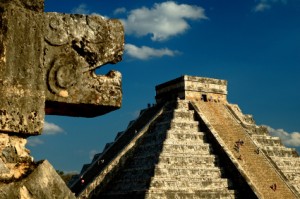 In America during the prehistoric astronomical study developed a fairly extensive. Some observations Maya are well known, as the lunar eclipse of February 15, 3379 BC They had their own solar calendar and knew the timing of the eclipses. Inscribed on stone monuments formulas to predict solar eclipses and the heliacal rising of Venus.
In America during the prehistoric astronomical study developed a fairly extensive. Some observations Maya are well known, as the lunar eclipse of February 15, 3379 BC They had their own solar calendar and knew the timing of the eclipses. Inscribed on stone monuments formulas to predict solar eclipses and the heliacal rising of Venus.
If the different peoples of ancient Mexico reached the stage hieroglyphic, the Maya managed syllabic-alphabetic phase in his writing. The numbering started by vigesimal based Olmec, the Maya perfected in the centuries III and IV a. C.
The Mayans knew from the third millennium BC C. at least one very versatile astronomical development. Many of his comments have come down to us (such as a lunar eclipse on 15 February 3379 BC) and were known with great accuracy the synodic revolutions of the planets, the frequency of eclipses etc. The schedule begins with a zero date is possibly the June 8, 8498 a. C. in our computation of time, but not sure. The Maya also had a year of 365 days (with 18 months of 20 days and an intercalary month of 5 days).
Studies on the stars that made the Maya continue to surprise scientists. His obsession with movement of the heavenly bodies was based on the cyclical conception of history, and astronomy was the tool used to determine the influence of the stars on the world.
The Maya solar calendar was more precise than we use today. All cities of the classical period are focused on the movement of the sky. Many buildings were constructed in order to stage celestial phenomena on Earth, such as El Castillo at Chichen Itza, which notes the decline of Kukulkan, snake formed by the shadows that are created in the corners of the building during the solstices. The four steps of the building totaling 365 steps, the days of the year. In the Codex Dresden and numerous trails are the calculations of the lunar cycles, solar, Venusian and tables of frequency of eclipses.
 Follow
Follow